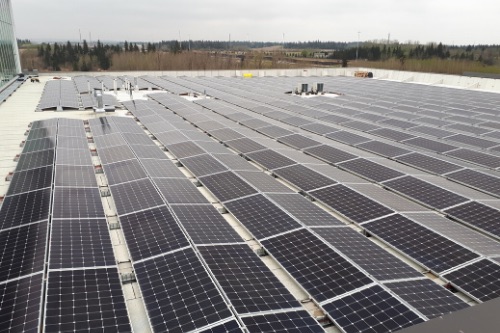Alberta
National recognition for RDC’s Alternative Energy Initiative

RDC’s Alternative Energy Initiative recognized nationally as a leader in sustainability
Red Deer College’s commitment to environmental stewardship has been recognized on the national stage with two honours.
The College is proud to be recognized by Clean50 for its use of sustainable technologies to provide learning and research opportunities for students, faculty and industry partners, as well as to reduce its energy consumption. In addition, RDC’s Alternative Energy Lab has received LEED (Leadership in Energy and Environmental Design) Silver certification from Canada Green Building Council.
Clean50 Top Project for 2021
RDC’s Alternative Energy Initiative has been named one of Canada’s Clean50 Top Project Award (https://clean50.com) winners and this project has been declared a Clean50 Top Project for 2021.
Clean50 celebrates innovation among organizations who contribute to a sustainable low-carbon Canadian economy to expedite collaboration and constructive change.
“RDC takes great pride in receiving this national recognition as a leader in sustainable technology, through the reduction of the College’s overall carbon footprint,” says Dr. Peter Nunoda, RDC President. “The Alternative Energy Lab, which is part of the College’s larger Alternative Energy Initiative, is a hub for alternate energy education and research, in addition to providing RDC’s faculty and students with opportunities to collaborate with, and support, central Alberta businesses.”
RDC’s Alternative Energy Initiative provides a framework to guide the College’s development as an alternative energy technology leader, reducing operational utility demands and costs.
The project submitted by RDC to Clean50 highlighted initiatives such as the College’s installation of more than 4,200 solar panels, which is the largest array among Canadian post-secondary schools, as well as a combined heat and power unit, replacement of exterior lighting with new energy efficient LEDs, and the Alternative Energy Lab, which is a vital teaching and learning space.
“RDC’s alternative energy projects play a significant role in reducing the institution’s carbon footprint which positively impact RDC’s operations and the environment. Electricity production at the College from alternative energy sources equates to powering 1,300 homes or removing 1,100 cars off the road each year,” says Jason Mudry, RDC’s Director of Campus Management.
“These projects also help RDC drastically reduce its utility costs by up to $750 thousand annually. These savings provide funds for use in other educational and operational initiatives.”
RDC’s Alternative Energy Initiative has vastly trimmed RDC’s use of external sources of electricity. At times, the College is able to sell power to surrounding communities in central Alberta as the largest independent electrical producer in Red Deer.
LEED Silver Certification for RDC’s Alternative Energy Lab
The College’s Alternative Energy Lab is among the newest learning spaces on RDC’s main campus, opening in 2019. This nationally-recognized LEED Silver certification highlights the College’s efforts to ensure the Lab embodies sustainability in its design, construction and ongoing operation.
“RDC’s Alternative Energy Lab offers tremendous value to a variety of stakeholders, including to more than one thousand students annually in a wide range of programs,” says Kylie Thomas, RDC Vice President Academic & Research. “The Lab enhances the entire immersive alternative energy educational experience for our students by offering an engaging platform to learn about these systems and apply their knowledge and skills to real-world situations. These incredible opportunities help prepare our learners for a variety of promising careers in the growing sector of alternative energy.”
Canada Green Building Council recognized RDC’s Alternative Energy Lab with LEED Silver certification for reasons including:
- the facility was built with a high-performance building envelope that has about fifty per cent more insulation value than a typical building
- an extensive photovoltaic array attached to the building that produces a significant amount of electricity for use in the Lab and other locations of main campus
- the Lab uses high-efficiency building mechanical systems to reduce energy consumption
RDC is also LEED certified with its Four Centres and Gary W. Harris Canada Games Centre. RDC’s new Residence was also designed with sustainability in mind, as it is constructed with renewable structural materials and a high-performance building envelope.
Alberta
Red Deer Justice Centre Grand Opening: Building access to justice for Albertans

The new Red Deer Justice Centre will help Albertans resolve their legal matters faster.
Albertans deserve to have access to a fair, accessible and transparent justice system. Modernizing Alberta’s courthouse infrastructure will help make sure Alberta’s justice system runs efficiently and meets the needs of the province’s growing population.
Alberta’s government has invested $191 million to build the new Red Deer Justice Centre, increasing the number of courtrooms from eight to 12, allowing more cases to be heard at one time.
“Modern, accessible courthouses and streamlined services not only strengthen our justice
system – they build safer, stronger communities across the province. Investing in the new Red Deer Justice Centre is vital to helping our justice system operate more efficiently, and will give people in Red Deer and across central Alberta better access to justice.”

Government of Alberta and Judiciary representatives with special guests at the Red Deer Justice Centre plaque unveiling event April 22, 2025.
On March 3, all court services in Red Deer began operating out of the new justice centre. The new justice centre has 12 courtrooms fully built and equipped with video-conference equipment to allow witnesses to attend remotely if they cannot travel, and vulnerable witnesses to testify from outside the courtroom.
The new justice centre also has spaces for people taking alternative approaches to the traditional courtroom trial process, with the three new suites for judicial dispute resolution services, a specific suite for other dispute resolution services, such as family mediation and civil mediation, and a new Indigenous courtroom with dedicated venting for smudging purposes.
“We are very excited about this new courthouse for central Alberta. Investing in the places where people seek justice shows respect for the rights of all Albertans. The Red Deer Justice Centre fills a significant infrastructure need for this rapidly growing part of the province. It is also an important symbol of the rule of law, meaning that none of us are above the law, and there is an independent judiciary to decide disputes. This is essential for a healthy functioning democracy.”
“Public safety and access to justice go hand in hand. With this investment in the new Red Deer Justice Centre, Alberta’s government is ensuring that communities are safer, legal matters are resolved more efficiently and all Albertans get the support they need.”
“This state-of-the-art facility will serve the people of Red Deer and surrounding communities for generations. Our team at Infrastructure is incredibly proud of the work done to plan, design and build this project. I want to thank everyone, at all levels, who helped make this project a reality.”
Budget 2025 is meeting the challenge faced by Alberta with continued investments in education and health, lower taxes for families and a focus on the economy.

Quick facts
- The new Red Deer Justice Centre is 312,000 sq ft (29,000 m2). (The old courthouse is 98,780 sq ft (9,177 m2)).
- The approved project funding for the Red Deer Justice Centre is about $191 million.
Alberta
Made in Alberta! Province makes it easier to support local products with Buy Local program

Show your Alberta side. Buy Local. |
When the going gets tough, Albertans stick together. That’s why Alberta’s government is launching a new campaign to benefit hard-working Albertans.
Global uncertainty is threatening the livelihoods of hard-working Alberta farmers, ranchers, processors and their families. The ‘Buy Local’ campaign, recently launched by Alberta’s government, encourages consumers to eat, drink and buy local to show our unified support for the province’s agriculture and food industry.
The government’s ‘Buy Local’ campaign encourages consumers to buy products from Alberta’s hard-working farmers, ranchers and food processors that produce safe, nutritious food for Albertans, Canadians and the world.
“It’s time to let these hard-working Albertans know we have their back. Now, more than ever, we need to shop local and buy made-in-Alberta products. The next time you are grocery shopping or go out for dinner or a drink with your friends or family, support local to demonstrate your Alberta pride. We are pleased tariffs don’t impact the ag industry right now and will keep advocating for our ag industry.”
Alberta’s government supports consumer choice. We are providing tools to help folks easily identify Alberta- and Canadian-made foods and products. Choosing local products keeps Albertans’ hard-earned dollars in our province. Whether it is farm-fresh vegetables, potatoes, honey, craft beer, frozen food or our world-renowned beef, Alberta has an abundance of fresh foods produced right on our doorstep.
Quick facts
- This summer, Albertans can support local at more than 150 farmers’ markets across the province and meet the folks who make, bake and grow our food.
- In March 2023, the Alberta government launched the ‘Made in Alberta’ voluntary food and beverage labelling program to support local agriculture and food sectors.
- Through direct connections with processors, the program has created the momentum to continue expanding consumer awareness about the ‘Made in Alberta’ label to help shoppers quickly identify foods and beverages produced in our province.
- Made in Alberta product catalogue website
Related information
-

 2025 Federal Election2 days ago
2025 Federal Election2 days agoPolls say Canadians will give Trump what he wants, a Carney victory.
-

 2025 Federal Election2 days ago
2025 Federal Election2 days agoPoilievre’s Conservatives promise to repeal policy allowing male criminals in female jails
-

 2025 Federal Election2 days ago
2025 Federal Election2 days agoCarney Liberals pledge to follow ‘gender-based goals analysis’ in all government policy
-

 2025 Federal Election2 days ago
2025 Federal Election2 days agoTrump Has Driven Canadians Crazy. This Is How Crazy.
-

 Entertainment1 day ago
Entertainment1 day agoPedro Pascal launches attack on J.K. Rowling over biological sex views
-

 2025 Federal Election2 days ago
2025 Federal Election2 days agoThe Anhui Convergence: Chinese United Front Network Surfaces in Australian and Canadian Elections
-

 conflict1 day ago
conflict1 day agoTrump tells Zelensky: Accept peace or risk ‘losing the whole country’
-

 2025 Federal Election1 day ago
2025 Federal Election1 day agoPoilievre Campaigning To Build A Canadian Economic Fortress





